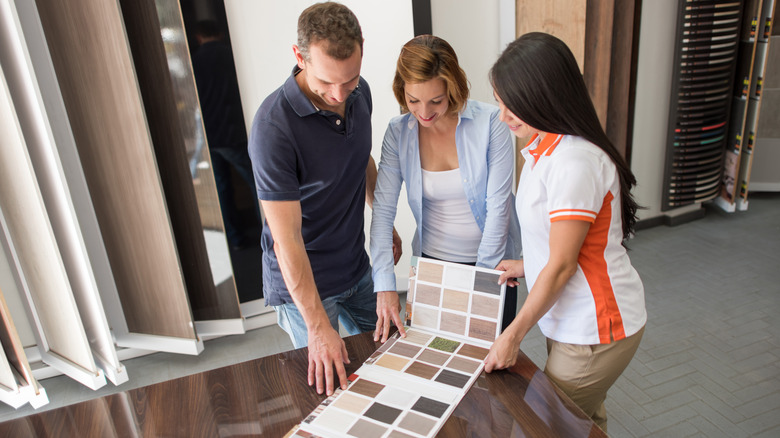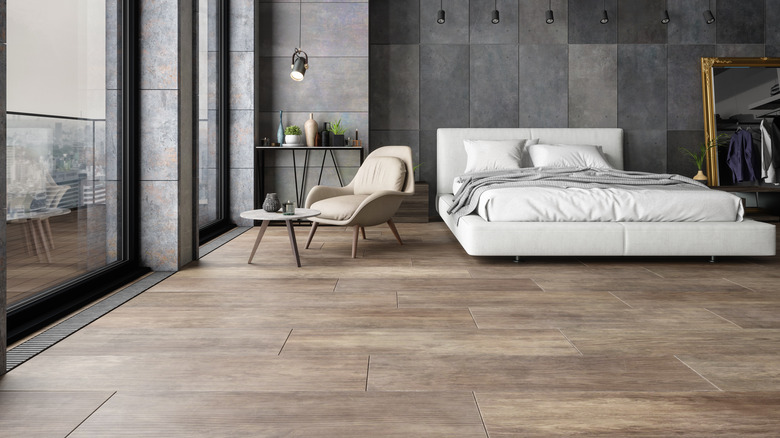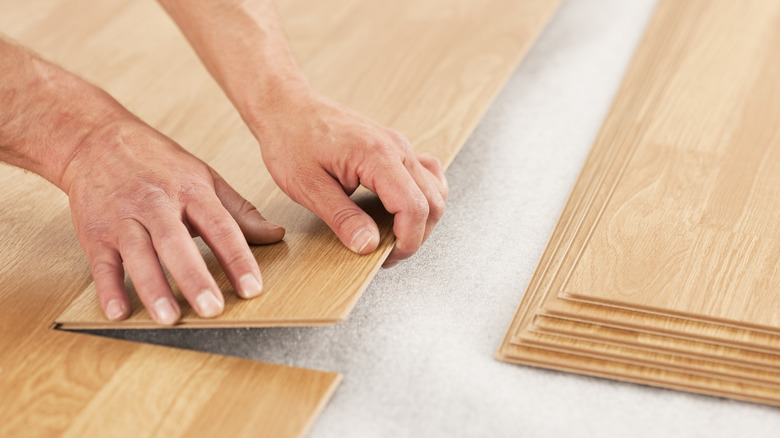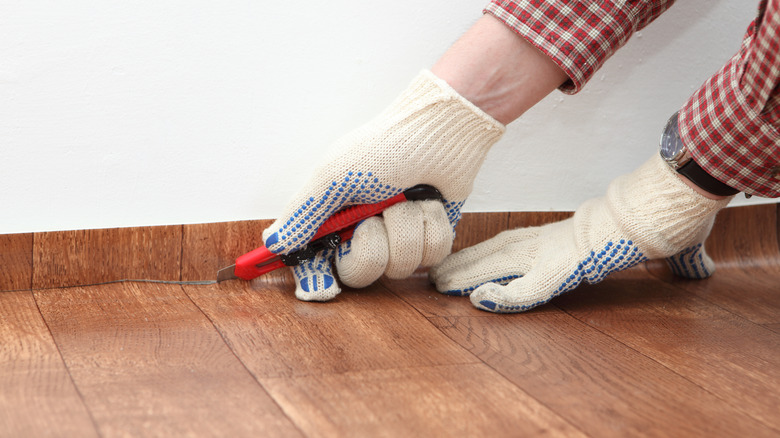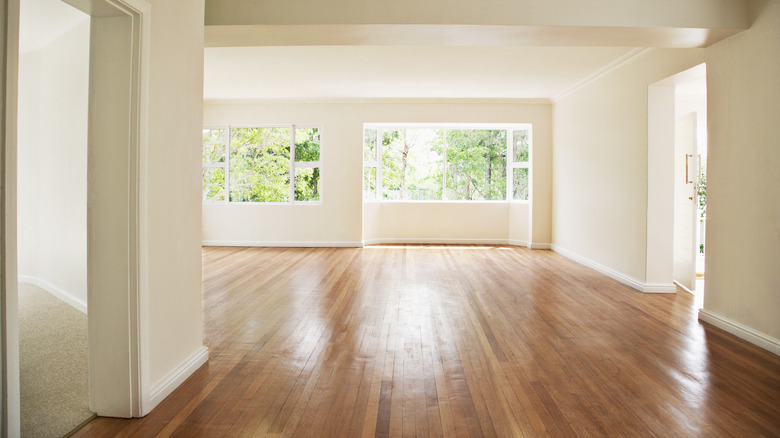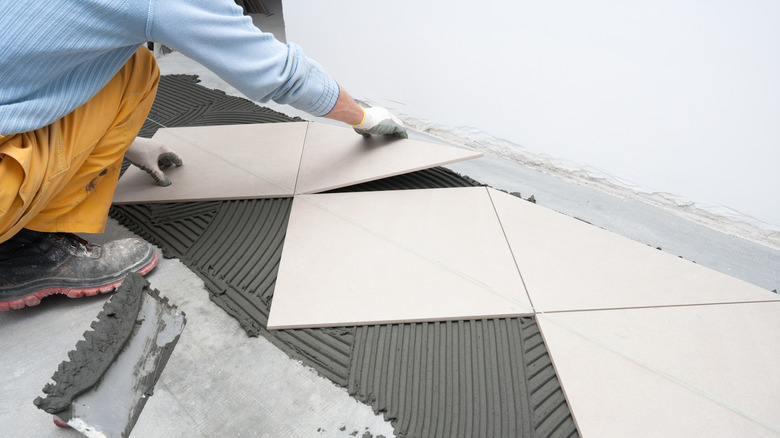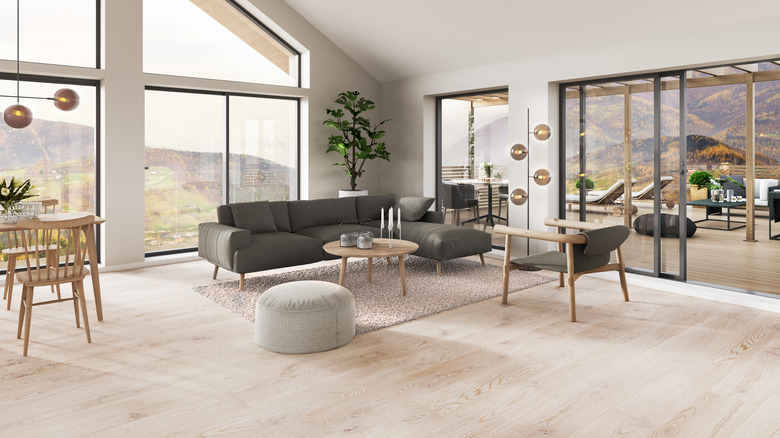Flooring Materials That Just Aren't Worth The Price, According To Our Experts
Buying new flooring for your home can be a difficult task, which is why we interviewed the experts for you. You deserve to know what's worth it and what isn't, so you get the best value for your money while maintaining style."Overall, the most important things to think about when choosing floors are the upkeep needed, how long they will last before needing to be replaced, and your budget," Adrian Pedraza, Owner of The California Home Buyer, a professional house-flipping company, told HouseDigest in an exclusive interview. "Doing research on the best (and worst) materials can help you pick floors that will still look good years later without breaking the bank."
In most cases, this research will reveal that a higher pricetag can often mean more work without a noticeable uptick in quality to go along with it. Jason Pietruszka, Interior Designer, Contractor, and Real Estate Developer at JJP Construction Inc., can't help but agree. "Luxury materials are kind of funny in the way that they are the most expensive, but they are the most delicate and require the most amount of care," he told us. "Whereas, if you go with the cheaper materials, they are usually pretty durable, and have a pretty long lifespan." No matter what you choose, here is what these experts and their peers warn isn't worth the price.
Older homes can't handle large-format tile
"The secret is matching your flooring with the limitations of the home that you are installing it into," Jeff Thorman, Host of Home RenoVision DIY shared with HouseDigest in an exclusive interview. "For example, the more modern the home, the more it has been designed for the installation of larger format flooring. Engineered floor joists create an incredibly flat surface which allows for the installation of oversized tile."
Yet older homes don't have this flexibility and you might find yourself boxed in. "The older the home, the more limitations you will have on product selection based on the difficulty to install in unlevel environments," Thorman explained. Of course, you can always use a floor-leveling compound to "achieve the desired conditions for installation but dramatically increase the overall cost of the project." For this reason, you have to think about the environment you are placing the flooring into before you can decide if it's worth it or not. While large-format tile might be less expensive per square foot than other options, prepping the space might blow your budget if you have an older home. In this case, it's not worth it.
Laminate flooring can't handle high traffic
If you have a busy home, avoid installing laminate flooring. "It is very fragile and with too much traffic on it, it will be ruined quickly," Jason Pietruszka warned. In addition to these durability concerns, laminate doesn't have many repair options if it does get damaged. Unlike an option like hardwood flooring, which can be sanded and refinished to repair scratches and damage, you can't do much with laminate. Once you mess them up, laminate planks cannot be repaired or refinished. Instead, you have to entirely replace each of the impacted planks. This process can be time-consuming, costly, and challenging, especially if the original flooring is no longer available or if the replacement planks do not match the existing ones.
On top of that, the fragile nature that Pietruszka emphasized can contribute to a lack of warmth and comfort in a space. Laminate flooring may feel cold and rigid underfoot, particularly in colder climates or during the winter months. This makes it less inviting and comfortable for homeowners and their families.
Linoleum floors aren't worth the hassle
"When it comes to floors that may not be worth the money, here are a few things I've noticed: Linoleum floors can be slippery when wet and get scratched or dented pretty easy if you have kids or pets around," Adrian Pedraza, Owner of The California Home Buyer, a professional house-flipping company, told HouseDigest in an exclusive interview. "You also have to put wax on them sometimes to protect the surface, which takes extra work."
The waxing is an essential step in the maintenance of linoleum flooring. You do it because it helps shield against wear, restore luster, and prevent discoloration. It is also supposed to improve resilience and prolong the lifespan of linoleum flooring. But it can take a long time and be quite exhausting work. "For the price of installing linoleum, you may be better off choosing vinyl floors that are more durable instead," Pedraza advised.
Solid hardwood floors require too much upkeep
More expensive doesn't always mean better when considering flooring options. "When it comes to covering your floors, some options simply aren't worth the high price because of all the extra work involved, Eric Bramlett, realtor and owner of Bramlett Residential told HouseDigest in an exclusive interview. "When it comes to covering your floors, some options simply aren't worth the high price because of all the extra work involved."
For Bramlett, solid hardwood floors are at the top of the list."Sure, they look amazing, but you'll need to refinish them every few years," he said. "Plus you'll always be stressed about scratches and water damage. In busy areas, that can quickly become a real hassle." Jason Pietruszka is quick to agree, saying "Solid wood is usually pretty expensive, but it can get knicks and dents in it." This is unfortunate, as solid hardwood floors are such a classic look. Many homeowners want to have them — so what's the best alternative? "Instead of dealing with those maintenance headaches, I usually suggest looking at engineered hardwood. [It] combines that beautiful wood look with a base that won't warp as easily, reducing refinishing and lowering stress about damage," Bramlett said. If you don't want to overspend but still want that great look, it's the only reasonable choice. "It gives me the same outcome for a lot less," Pietruszka said.
Waterproof tiling might break the bank
Tiling can be a great choice for areas of the house that get quite wet. However, you might not know that tiles are not automatically waterproof. You actually need to seal them to make them that way. Depending on the job, it can add up quickly and make the price tag too big to be worth it. "Tiles for the kitchen or bathroom can be costly depending on the style you pick. It's also important to waterproof them so moisture doesn't cause damage," shared Adrian Pedraza. "I've seen tile jobs run over $4,000 before! That's a lot to spend when other waterproof options like porcelain or marble could be more affordable alternatives."
So before installing tiling a floor because you think it's the cheaper option, be sure to zoom out a little bit. Consider the full price of the job, from start to finish, when you select the material. This includes raw material costs, installation labor, and extra installation bits like waterproofing or sealing. You should also consider making up for any tiling mistakes, plus long-term costs like maintenance and the average lifespan of the material.
Luxury vinyl flooring isn't that luxurious
You might be tempted to install luxury vinyl flooring in your home, as it seems like a great option. After all "luxury" is right there in the name! However, don't be fooled as there are many variations of the material, and not all of them are created equally. "Cheap luxury vinyl that has a flimsy base layer [is an issue]," Eric Bramlett said. "While vinyl floors are usually fantastic, the ones that are really cheap and have thin, stiff bases just ask for trouble."
The issue with these cheap bases is that everyday wear and tear in a home can nearly destroy your flooring, and quite quickly at that, as well. "Heavy furniture will make dents, and the whole thing might not last very long over time." Instead, Bramlett recommends investing in a higher-grade vinyl option. "They mimic wood perfectly while offering great toughness and resistance to water," he advised. "Just make sure to search for a wear layer that's at least a third of an inch thick for better scratch resistance." You can also keep an eye out for options with a stone composite base layer, as Bramlett thinks those tend to hold up well, too.
Carpet can easily get expensive — and damaged if you aren't careful
Carpet seems like a classic flooring option, but the type really matters when considering price and longevity. "Carpet is comfortable under your feet but more likely to get dirty or stained over time," Adrian Pedraza shared. "Wool carpets last longer than synthetic ones, but wool can be very expensive. You'll have to replace carpet more often than harder flooring types too. I usually suggest saving your money for furnishings instead of fancy carpets."
To get the best of both worlds, reach for a mid-range carpet material. You don't want the cheap, almost plastic feeling carpet that seems to pop up in most rental properties. Yet you don't need to break the bank on the nicest option, either. Instead, per Pedraza's advice — choose something that is soft enough to be comfortable, easy enough to clean, and is in a color that can hide stains and grime.

